 During these dog days of summer, many homeowners are making a very expensive mistake. Here in San Diego, homeowners are opening their SDG&E envelopes and getting sticker shock with astronomically high utility bills. What homeowners don’t realize is that by making a very simple change, they can save a great deal of money.
During these dog days of summer, many homeowners are making a very expensive mistake. Here in San Diego, homeowners are opening their SDG&E envelopes and getting sticker shock with astronomically high utility bills. What homeowners don’t realize is that by making a very simple change, they can save a great deal of money.
So here’s the tip: CLOSE YOUR FIREPLACE DAMPER!
What is a flue and what is a damper?
These terms are not interchangeable.
The flue is the vent pipe that allows gases, smoke, and heat to exhaust out of the home. The damper is a metal plate that opens and closes off the flue. When the fireplace is not in use, the damper should be closed in order to close off the flue.
Dampers are typically located at the bottom of the flue pipe, just above the firebox in the throat of the system.
Dampers typically have a rod or handle that you can push forward or backward. Other dampers move side to side, while others pull down or push up. It all depends on the type of fireplace you have.
In some cases, dampers can be located at the very top of the flue pipe with a chain that comes down and hooks in a bracket inside the firebox. These are called “top-mount” dampers. To close these dampers, you pull the chain down and hook it in the bracket. To open, you unhook the chain from the bracket and the damper plate pops open at the top because it’s spring activated.
Not all fireplaces have dampers but most do.
Why it’s important to close dampers
Here in San Diego, because our weather is typically very mild, many homeowners leave their dampers open all the time, not realizing that by doing so, their air conditioner is working overtime, costing the homeowner unnecessary money.
When the air conditioner is on and the damper is open, hot air from the outside is being drawn down the chimney and into the room. You’re actually sucking the hot air into your house. It totally defeats the whole purpose of using your air conditioner. In addition, if your chimney is dirty, you’re also sucking particulates of soot, which is a carcinogen, into the home. This is another reason to keep your chimney clean and your damper closed when the chimney is not in use.
It’s not just summertime that open dampers create problems. During winter time, when it’s cold outside, if your damper is open and you turn on your furnace, all you’re doing is sucking cold air into the home. This totally defeats the whole purpose of having your furnace turned on. So keep the damper closed during the winter time when you’re not using your fireplace.
How to tell if dampers are open
It’s not always easy to tell if your damper is open or closed. In fact, this is the #1 question when homeowners call me about their chimney. Unfortunately, because dampers open differently based on what type of system you have, I can’t give a conclusive answer over the phone. Here are several ways to tell if your throat damper is open or closed:
1) It’s actually easier to tell during the daytime than at night. One way you’re going to see more light from the sun than the other way. Keep in mind that because chimneys are not built straight up and down, you’ll rarely ever be able to see blue sky but one way you’ll be able to see more light than the other.
2) With a flashlight, look up from the firebox into the flue pipe. You should be able to see the metal damper plate in the throat of the system. When it’s open, you’ll actually feel more air movement than when it’s closed.
3) Light a match and blow it out. Immediately place the match close to the damper. The smoke from the blown-out match will indicate if the damper is open or closed.
4) Of course, there’s always the method that many homeowners use. Light the fire on a wing and a prayer. If it smokes out your house, then you know your damper is closed. We do not recommend this method due to the smoke damage to your home and to your lungs!
Here are examples of open and closed dampers. This is looking from the firebox (where you make the fire) up the flue pipe:
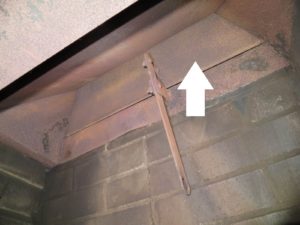
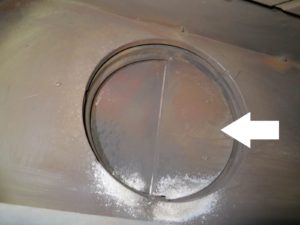
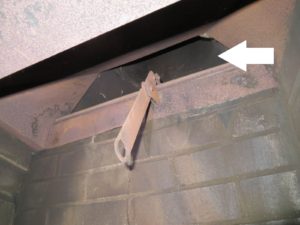
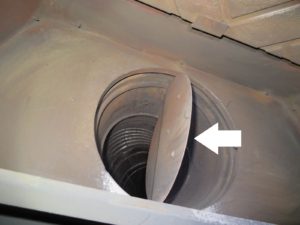
An Important Tip to Remember about Dampers
It’s not easy to remember, from season to season, which way the damper is open and which way is closed. To help me, I made a label and stuck it to the underside of the mantle which tells me which way to open. If I forget, I know where to look to find out easily. Here’s the label I had on the underside of my own mantel:
![]()
Not all dampers open this way so find out which way yours is open and make a label to place on the underside of your mantel.
Damper clamps
If your firebox is plumbed for gas, either for gas logs or a log lighter for burning with wood, then the damper has to be locked in a fully-open position with a clamp. You will not be able to close your damper. This is required by code in most areas of the United States. In this case, you may consider glass doors on the front of the fireplace.
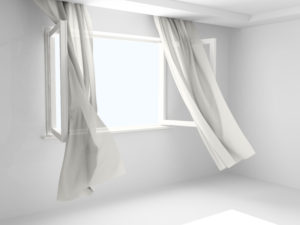 Remember, an open damper is the same as an open window. Would you leave a window open when your air conditioning or furnace is on? Then why would you leave your fireplace damper open?
Remember, an open damper is the same as an open window. Would you leave a window open when your air conditioning or furnace is on? Then why would you leave your fireplace damper open?
